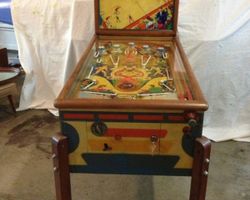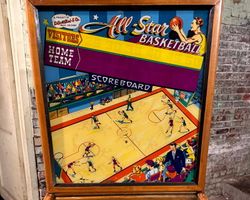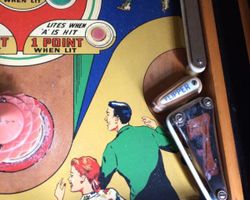All-Star Basketball

Average Price: USD $900
Produced: January, 1952
Production Run: 1,000 units
Machine Type: Electro-mechanical
Players: 1
Design by: Wayne Neyens
Art by: Roy Parker
D. Gottlieb & Co., a prominent manufacturer in the early decades of pinball, released "All-Star Basketball" in January 1952. This electro-mechanical (EM) machine, designated Model Number 61, tapped into the widespread enthusiasm for basketball, translating the dynamic sport into a pinball experience. The machine emerged from a period when pinball was rapidly evolving, moving beyond simple flipper-less games to intricate playfields demanding skill and strategy.
The design and production of "All-Star Basketball" were largely spearheaded by Wayne Neyens, who is credited with the machine's design, concept, animation, and mechanical engineering. Neyens' approach to pinball design often favored clear objectives and a satisfying flow, characteristics evident in this title. Complementing his mechanical vision was the artistry of Roy Parker, who crafted the machine's visual identity. Parker's distinctive style brought life to the basketball theme, contributing significantly to the machine's aesthetic appeal. With a production run of 1,000 units, "All-Star Basketball" was a modest release for its time, yet it became a representative example of Gottlieb's early 1950s output and the popular "woodrail" era of pinball manufacturing.
Signature Features and Design
"All-Star Basketball" distinguishes itself through a blend of mechanical ingenuity and thematic artistry typical of Gottlieb's woodrail era. As an electro-mechanical game, its features operate through relays, solenoids, and physical mechanisms, offering a distinct tactile and auditory experience. The machine includes two flippers, positioned at the bottom of the playfield, alongside three pop bumpers that provide lively ball redirection. Five passive bumpers are strategically placed, acting as targets and scoring opportunities. Two slingshots at the lower sides of the playfield offer further deflection, and a single kick-out hole adds an element of reward for specific shots.
A prominent feature that elevates the thematic integration is the backglass light animation. This display depicts basketball players in motion on a court, visually progressing with certain playfield actions. Every time a bumper is hit on the playfield, the backglass animation advances, simulating the movement of players until a "point is made." This real-time visual feedback creates a direct link between physical playfield interaction and the overarching basketball narrative, immersing the player in the game's theme beyond mere scoring. The artwork, skillfully rendered by Roy Parker, captures the energy of a basketball game, with players, hoops, and court elements adorning both the playfield and backglass. The color palette and visual style reflect the aesthetic of 1950s sports illustration, making the machine a vibrant representation of its era.
Playfield and Mechanics
The "All-Star Basketball" playfield presents a layout that encourages precise shot-making and strategic navigation. At the top of the playfield, two rollover lanes, designated 'A' and 'B', serve as initial objectives. Successfully activating both of these rollovers lights a "Special" target located at the very top of the playfield, offering a replay award upon subsequent hits. Below these rollovers, a series of five passive bumpers are arranged, numbered 1 through 5. These bumpers are central to one of the machine's primary scoring objectives.
The flow of "All-Star Basketball" is designed to guide players through a sequence of targets to achieve significant awards. The primary goal involves hitting the passive bumpers numbered 1 through 5 in sequence. Following this, the ball must activate "rebounds" (likely designated targets or switches numbered 6 and 7, possibly located near the bottom or sides of the playfield) to complete the sequence. Successfully executing this series lights the kick-out hole for a replay. This multi-stage objective demands accuracy and ball control, encouraging players to work their way up the playfield to initiate the sequence, then manage the ball's descent to complete it.
The lower playfield features three pop bumpers that create dynamic, unpredictable ball movement, often sending the ball towards the two slingshots. These slingshots, positioned above the flippers, are critical for ball deflection, but can also be a source of frustration if not managed adeptly. Roy Parker's artwork on the playfield is meticulously integrated with the mechanical layout. Lines resembling a basketball court delineate areas, while illustrations of players and basketballs adorn the surfaces, enhancing the thematic immersion. Lighting on the playfield is focused on illuminating the active targets and pathways, guiding the player's attention to the current objectives and progress towards replay awards. The overall aesthetic is one of clean lines and clear objectives, characteristic of early EM designs.
Gameplay Dynamics
The gameplay dynamics of "All-Star Basketball" revolve around a combination of controlled shooting and strategic target progression, typical of early electro-mechanical machines. The scoring system is straightforward yet engaging, primarily focused on earning replays. The core progression involves two distinct pathways to achieve this. The first, and arguably most challenging, requires players to systematically hit the five numbered passive bumpers (1 through 5) and then trigger two "rebound" targets (6 and 7). Completing this specific sequence illuminates the kick-out hole, which, when the ball enters it, awards a replay. This objective necessitates a deliberate approach, aiming for specific targets rather than simply keeping the ball in play.
The second primary method for earning replays involves the 'A' and 'B' rollover lanes at the top of the playfield. Successfully activating both of these lights the "Special" target, also located at the top. Each subsequent hit on this lit "Special" target grants an additional replay. This objective encourages skillful shots to the upper reaches of the playfield, often requiring precise nudging and flipper control to guide the ball into these narrow lanes.
A unique interactive element ties the playfield action to the backglass animation: hitting any bumper on the playfield advances the player light animation on the backglass until a "point is made." This visual feedback reinforces the basketball theme, giving a sense of progress even during less targeted shots. The challenge in "All-Star Basketball" often lies in managing the lower playfield. The two bottom slingshots are particularly active and can make it difficult to control the ball, frequently directing it towards the drain. Players must employ effective nudging techniques to keep the ball in play and guide it towards the upper playfield, where the key objectives for replay are located. Reaching the top of the playfield is paramount for both the 'A' and 'B' rollover sequence and to initiate the bumper sequence for the kick-out hole.
Reception and Legacy
"All-Star Basketball" holds a positive standing within the pinball community, particularly among enthusiasts of electro-mechanical machines and woodrail designs. Its strength lies in its ability to deliver a fun and engaging experience that captures the "heart and soul" of older pinball games. Players often praise the playfield layout, attributed to Wayne Neyens, for its thoughtful design and clear objectives, which remain enjoyable despite the machine's age. Roy Parker's artwork is consistently highlighted as a major positive, contributing significantly to the machine's charm and visual appeal. The craftsmanship inherent in these earlier Gottlieb woodrail machines is also a point of appreciation, with many considering them timeless classics that embody a distinct era of pinball manufacturing.
However, "All-Star Basketball" is not without its recognized challenges. A frequently cited difficulty stems from the machine's bottom slingshots, which are often perceived as highly active and difficult to manage. This can lead to rapid drains if players do not employ constant and precise nudging. Some players also suggest that the machine's leveling can contribute to difficulty in getting the ball to the upper sections of the playfield, where the most rewarding objectives reside. This specific feedback indicates that optimal setup is crucial for a balanced and rewarding experience.
"All-Star Basketball" maintains a reputation as a fine example of Gottlieb's output during the early 1950s. While it may not have introduced entirely new mechanics that revolutionized the industry, its coherent theme, engaging objectives, and the collaborative talent of Wayne Neyens and Roy Parker solidified its place as a well-regarded classic. Its significance lies in its embodiment of the design principles and aesthetic sensibilities of the woodrail era, showcasing how thematic elements could be seamlessly integrated with mechanical play through features like the backglass animation. For collectors and enthusiasts, it stands as a testament to the enduring appeal of electro-mechanical pinball, offering a glimpse into a foundational period of the hobby.
Sponsored Links
 Ebay Listings
Ebay Listings
 Auction Results
Auction Results
| Cost | Location | Date |
|---|---|---|
| USD $900 |  Ohio, United States Ohio, United States |
12 September, 2024 |
| USD $900 |  Pennsylvania, United States Pennsylvania, United States |
27 December, 2019 |
| USD $1,000 |  Connecticut, United States Connecticut, United States |
23 October, 2017 |
| USD $920 |  Ohio, United States Ohio, United States |
28 July, 2013 |


Private Policy · Search Website · Contact Us
As an eBay Partner, we may earn a commission from qualifying purchases made through links on this site, at no additional cost to you.
All trademarks and copyrighted materials remain property of their respective owners. All other content copyright 2007 - 2025 Pinpedia.



